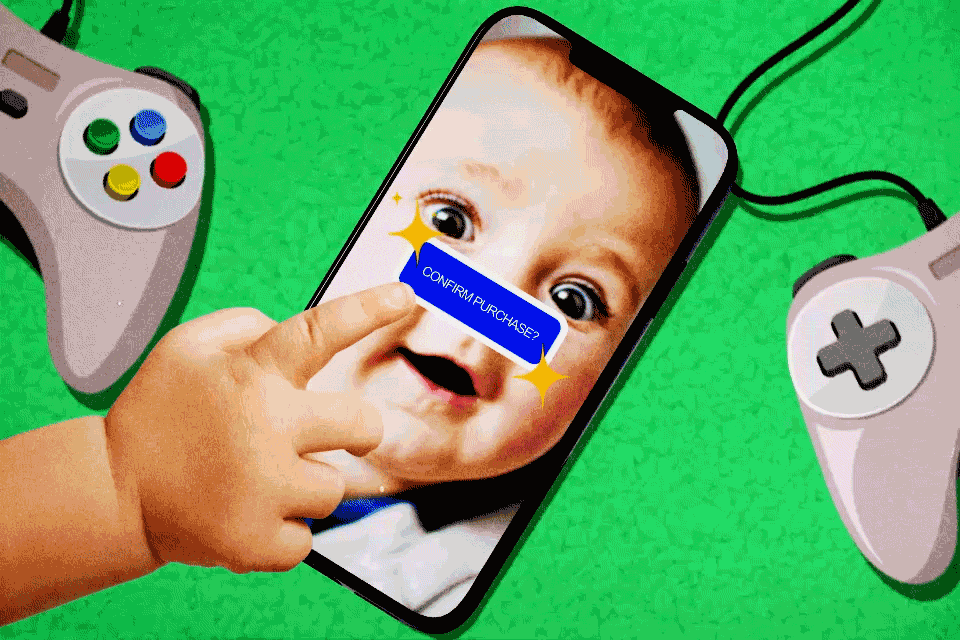Kids can wreak havoc on their parents' devices. Experts explain how to avoid a tech horror story.

Detroit mother of two Liz Caron was busy making lunch for her kids when she received a text from her husband: “Why did you just spend $200 on PlayStation purchases?” Caron, who not only never played with the PlayStation but also knew that the system was turned off, racked her brain. Then her 2-year-old son, Elliot, walked by gripping the controller and making video game sound effects. “Look Mom, I’m playing!”
Elliot, who had made enough purchases to satisfy any adult gamer, inspired the family’s new lockdown policy. “We have since put passwords on everything,” Caron tells Yahoo Life.
For parents who are living in the age of digital media and raising children with cellphones, voice-dictation speakers and iPads that even the tiniest thumbs can maneuver, trying to figure out the number of devices to secure and how to secure them can be overwhelming. We didn’t grow up with this stuff. We’ve all heard the horror stories: the boy who bought $2,600 worth of ice cream online, the 3-year-old who locked his dad out of his iPad for 48 years. And we’ve all experienced them ourselves: the string of unicorn emojis underneath an ex's Instagram post, the gibberish emails sent to bosses, etc. Just last month my teething 1-year-old brought the police to our home with some innocent phone munching.
Expert tips for kid-proofing devices
So what can parents do to secure their devices in this age when even toddlers can flex big spending muscles? Child psychologist Adam Pletter, creator of iParent 101, has some advice. “In general I recommend starting with a media plan to set basic expectations and evolving rules, just like any parenting set of decisions,” he tells Yahoo Life.
Implementing media plans with older children is no small task, especially when they are getting their own phones, but for parents with young children, these digital boundaries can be harder to communicate. So what’s a parent of littles to do?
“They’re basically never too young for parents to set up a basic media plan. You wouldn’t let a toddler get behind the wheel of a car, nor would you want to give them unlimited access to an adult’s device,” explains Pletter.
This doesn’t need to be difficult. Pletter recommends setting up very basic media plans with two or three expectations: when the device can be used and for how long (using a visual timer), and where it goes at bedtime. He recommends making a chart to communicate these guidelines visually with clip art or stickers, and prioritizing educational content before pure entertainment.
“You’re teaching them how to have a healthy relationship with technology now, so that as they age and eventually get their own devices, they will understand how to maintain that relationship,” says Pletter. “It’s not just about their relationship with tech, but their relationship with tech and you. Creating a dialogue surrounding devices from a young age teaches kids that you will be a part of their relationship with these devices in the future. That this is an open dialogue and something that you are there to help them monitor and protect.”
There are also practical steps you can take. For those with an iPhone or iPad, Guided Access can restrict these devices temporarily to a single app, disabling areas of the screen where any small pudgy fingers could make a colossal shopping mistake. Android phones have an equivalent tool called Screen Pinning (or App Pinning) that similarly locks the device’s screen to the specific app chosen.
For those who’ve had the innocent questions about the sizes of sperm whales to their Google Nest/Alexa/Echo/etc. go in a different direction, there are parental controls you can set up to block explicit music, videos, news or podcasts and even schedule downtime.
How parents can set a better example
Setting up parameters and locks, it turns out, may be the easy part. The trickier part, as Devorah Heitner, author of Growing Up in Public: Coming of Age in a Digital World, suggests, is changing our own behavior.
“As parents and role models, we need to hold ourselves accountable for the behaviors we may be unconsciously modeling for our kids, like using the very tech we complain about to monitor them, or sharing photos of them without their consent,” Heitner says. She suggests modeling unplugged behavior at meals or other family times, and limiting or avoiding using Alexa and Siri.
“I realize that my kids must be so fascinated by my phone because it’s what I’m looking at all the time,” says Riley Rietema, a Chicago father of two. He’s started taking small measures to reduce phone use by wearing a watch and getting subscriptions to print newspapers and magazines, so he avoids reading exclusively on his phone and his kids can see what it is he is doing. He’s also removed social media apps from his phone so he’s less tempted to doom scroll. “My kids are fascinated by all the things they see me use: the remote, the lawnmower, the car, a wallet. Why would the phone be any different? Maybe the best way to win this fight is to make my phone unappealing to everyone, even me.”
Our last resort is to try to at least imbue some sense of good taste in our children, so the next time there’s a $1,000 slip-up, they’ll maybe order something we like too.
